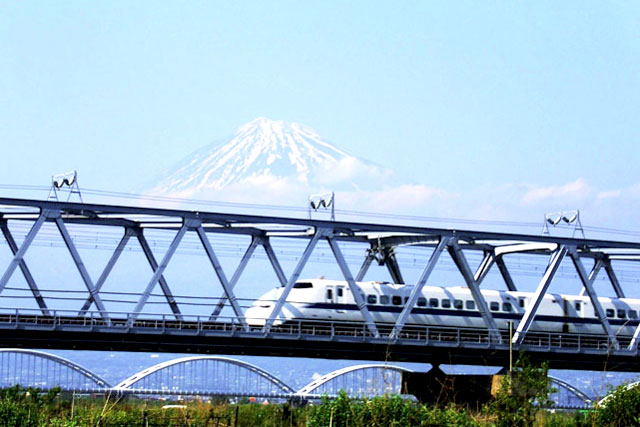Japan is a splendid blend of traditions and modern culture with several sites reminding you of the country’s unique character. We’ve compiled a list of 10 iconic sights in Japan you shouldn’t miss. Travel with a Japan Rail Pass and discover these places for yourself while enjoying comfortable train rides on some of the world’s fastest trains: the famous Shinkansen “bullet trains”. The list includes modern Tokyo, awe-inspiring Mt. Fuji, majestic temples around Kyoto and much more. Read all about the landmarks that make us want to pause and take pictures.
1. Mt Fuji
Mt. Fuji is Japan’s highest mountain and perhaps its most iconic landmark. While climbing Mt. Fuji is a popular activity among hikers, you can also enjoy Mt. Fuji as a natural background while staying in its surrounding area. For example, a lot of outdoor activities can be enjoyed while staying in Fujigoko, a lake resort area at the northern base of the mountain. Not only can you catch an amazing view of Mt. Fuji from Fujigoko, but camping, fishing and snow sports, along with hot springs and even an amusement park will keep you occupied throughout your stay. Note that you can get great snapshots of the mountain while traveling on the shinkansen running between Tokyo and Osaka.
2. Himeji Castle
Himeji is famous for being the home of one of Japan’s most impressive castles: Himeji Castle. It’s easy to understand why: its location on top of Himeyama Hill, its sheer size combining 83 buildings, its nickname the White Heron Castle… everything about Himeji Castle screams ‘majesty’. The castle has the distinction of being one of only a few Japanese castles still in its original form, as it survived wars, fires and earthquakes. Adding to its fame, Himeji Castle was one of the locations used for shooting the James Bond film You Only Live Twice and is also frequently featured in domestic and foreign films. You can reach Himeji from Kyoto in under an hour by Shinkansen bullet train.
3. The Great Buddha of Kamakura
Cast in bronze, the Great Buddha of Kamakura weighs nearly 93 tons and is over 13 meters (40 feet) in height making it the second tallest Buddha statue in Japan, bested only by the one inside Todai-ji Temple. Still, it remains one of the most imposing statues you will meet. The Great Buddha of Kamakura was originally located inside a large temple but the buildings were destroyed by typhoons and tidal waves, leaving the Great Buddha without a roof to sit under. You can reach the statue by taking the Enoden railway line which connects to Kamakura train station.
4. Todai-ji Temple
Todai-ji Temple is the world’s largest wooden building and the home of Japan’s largest Buddha statue. Several other works of art can be found inside Todai-ji Temple and many are considered National Treasures. The temple is located in the northern part of Nara Park, where you find hundreds of free-roaming deer, gardens, shrines and a National Museum specialized in Buddhist art. The closest stations to Todai-ji Temple are the JR Nara and Kintetsu Nara train stations located only a few minutes away from the park.
5. Fushimi Inari Shrine
Most people visit the shrine to explore the mountain trails as it features the “Senbon Torii”, which translates into a “thousand gates”. As you walk up the hiking trail you pass under countless lined up orange gates, each of which is a donation from individuals and companies. If you climb the mountain up to the Yotsutsuji intersection, less than half way up, you can enjoy a splendid view of Kyoto.
6. The Philosopher’s Path
The Philosopher’s Path is a stone path that’s about 2 kilometers in length. The path is lined by hundreds of cherry trees and follows a part of Lake Biwa Canal. It’s one of Kyoto’s most magnificent spots in the spring, as cherry trees blossom and turn the Philosopher’s Path into a romantic and spectacular spot for taking pictures.
7. The Golden Pavilion Temple
The Golden Pavilion Temple is a Zen Buddhist temple located in Kyoto. The top two floors of the temple are entirely covered in gold leaves which make for a stunning sight when contrasted with the beautiful gardens surrounding the temple and the large reflecting pond. To visit the Golden Pavilion Temple, you can take a Kyoto City Bus from Kyoto’s train station or use the subway lines. Keep in mind that city buses and the subway are not covered by your Japan Rail Pass.
8. Shibuya
This major shopping and entertainment area in Tokyo is also one of its most trendy and colorful. Neon signs, funky billboards and giant video screens are common sights on the large and busy Center Gai, a pedestrian zone in the heart of Shibuya. You can reach the district by getting off at the Shibuya train station on Tokyo’s Yamanote line.
9. The Floating Gate
The Floating gate (torii) of Itsukushima Shrine on Miyajima Island is almost synonymous with Japan, being one of the country’s most recognized symbols. At high tide, the bottom of the gate becomes submerged, leaving the impression that the gate is floating. Using your Japan Rail Pass, the island can be reached by train in 25 minutes from Hiroshima station.
10. Jigokudani Monkey Park
Jigokudani Monkey Park is not only famous for its hot spring, but also for the large population of snow monkeys that use the hot springs to keep warm during winter. During the day, the monkeys travel from cliffs and forests to sit in the warm hot springs of Jigokudani valley in Yamanouchi and when the evening comes, they disappear back into the forests.
Travel with a Japan Rail Pass and make your own great discoveries. The pass allows you to travel throughout Japan for 7, 14 or 21 consecutive days.







I really like to say Japan is a dreamland which attract all culture love like mine father.
Its really fablosu to me to read this sort of stuff here.